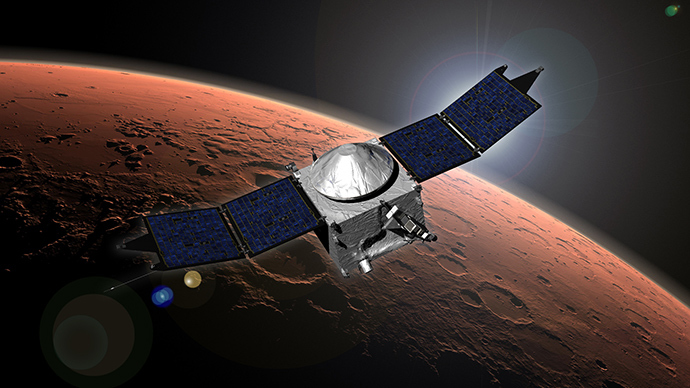NASA’s latest Mars spacecraft reveals secrets behind planet’s atmosphere

Less than one month after entering Mars’ orbit, the MAVEN spacecraft launched by NASA is already impressing scientists by supplying them with unprecedented new details about the Red Planet.
On Tuesday, NASA said in a statement that its Mars Atmosphere and Volatile Evolution, or MAVEV, spacecraft has “produced unprecedented ultraviolet images” that scientists are already analyzing along with other new information to learn more about the ancient atmosphere of Earth’s neighbor.
NASA launched MAVEN last November with the intent of having the high-tech spacecraft collect information previously unavailable to scientists; last month, NASA confirmed that the unit had entered Martian orbit around 442 million miles from Earth and would soon begin collecting data to send back for analysis.
"We want to better understand how the atmosphere is escaping from Mars," NASA research scientist Paul Mahaffy told ABC News back when the spacecraft was first launched last year. "Then, we can extrapolate back in time and ask, 'Was Mars' climate substantially different than it is today?'"
According to the latest report from NASA, scientists are already encountering success with their MAVEN project after only a few weeks in orbit.
"All the instruments are showing data quality that is better than anticipated at this early stage of the mission," Bruce Jakosky, MAVEN principal investigator at the University of Colorado, Boulder, said in a statement. "All instruments have now been turned on -- although not yet fully checked out -- and are functioning nominally. It's turning out to be an easy and straightforward spacecraft to fly, at least so far. It really looks as if we're headed for an exciting science mission."
"All the instruments have been turned on and are operating very well,” Jakosky added to CBS News. “The aim of our activities right now is to get to the start of science mapping, and that will be in early- to mid-November, depending on whether we encounter any problems. So far, we've encountered no problems whatsoever in the commissioning."

MAVEN, the NASA statement claims, “has provided scientists their first look at a storm of energetic solar particles at Mars, produced unprecedented ultraviolet images of the tenuous oxygen, hydrogen and carbon coronas surrounding the Red Planet and yielded a comprehensive map of highly-variable ozone in the atmosphere underlying the coronas,” all in just three weeks.
Those molecules, the statement continues, are key to understanding the four billion years of history concerning Mars because they directly affect climate and can provide scientists with an ideal glimpse of how the planet once was. MAVEN is equipped with an Imaging Ultraviolet Spectrograph, or IUVAS, that monitors the sunlight reflected off of those molecules and, according to NASA, is already revealing new details about the planet’s history.
Additionally, other sensors on MAVEN have already, according to scientists, collected details on solar energetic particles, or SEPs, emitted by the sun during solar flares, which is also expected to provide NASA with new details about Mars.
"With these observations, MAVEN's IUVS has obtained the most complete picture of the extended Martian upper atmosphere ever made," MAVEN Remote Sensing Team member Mike Chaffin added. "By measuring the extended upper atmosphere of the planet, MAVEN directly probes how these atoms escape to space. The observations support our current understanding that the upper atmosphere of Mars, when compared to Venus and Earth, is only tenuously bound by the Red Planet's weak gravity."














